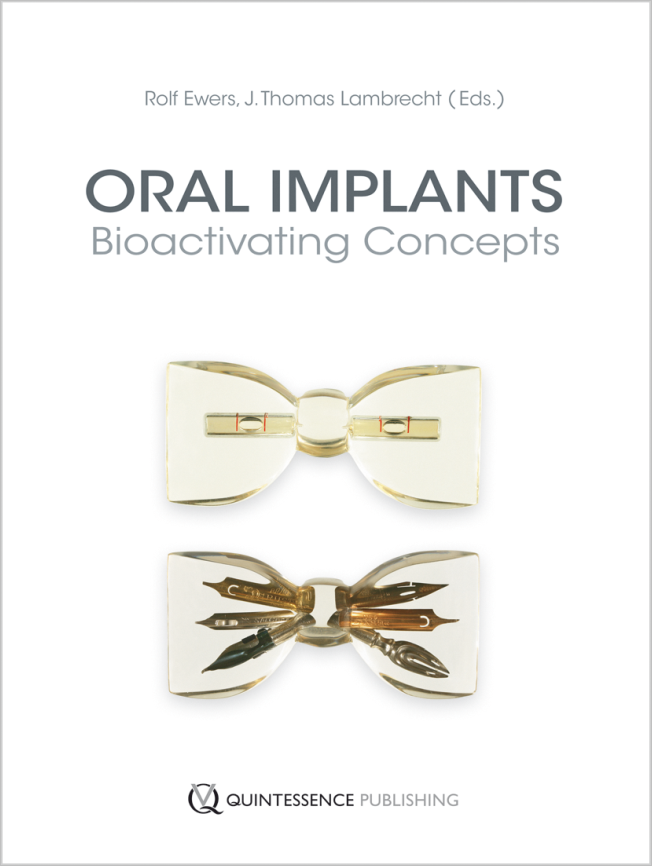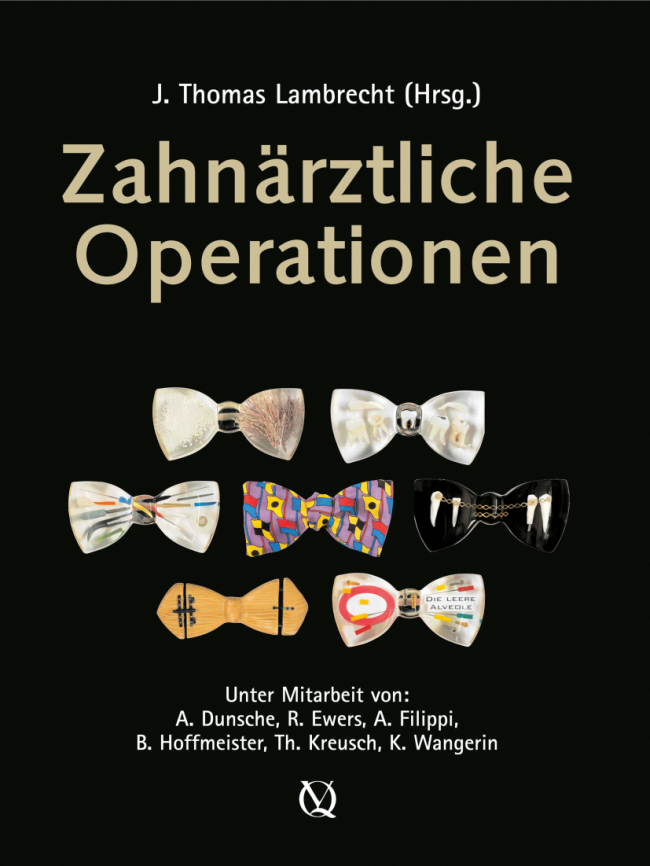Implantologie, 3/2024
Seiten: 287-300, Sprache: DeutschEwers, Rolf / Marincola, Mauro / Perpetuini, Paolo / Bonfante, Estevam A. / Cheng, Yu-Chi / Lauer, Günter / Truppe, Michael / Morgan, Vincent J.Im vorliegenden Beitrag soll erörtert werden, inwieweit die Zahl extrakurzer Implantate im atrophen Ober- und Unterkiefer reduziert werden kann und wie die entsprechenden Langzeit-Überlebensraten der Implantate und Prothesen sind. Dazu wurden 152 Patienten im Alter von 50–90 Jahren mit ausgeprägten Atrophien beider Kiefer mit einem, drei oder vier extrakurzen Implantaten (Integra-CPTM, Fa. Bicon, Boston, USA) versorgt. Insgesamt wurden 512 Implantate inseriert. Alle Patienten erhielten eine CAD/CAM-produzierte metallfreie faserverstärkte 10- bis 14-gliedrige implantatgetragene Kunststoffprothese. In der „All-on-four“-Gruppe wurden 18 Patienten (im Durchschnitt 61,22 Jahre alt) mit ausgeprägten Unterkieferatrophien mit 72 Implantaten versorgt und im Durchschnitt 55,4 Monate nachverfolgt. Die Implantat-Überlebensrate betrug 97,2 %. In der „All-on-three”-Gruppe wurden 45 Patienten mit einem Durchschnittsalter von 71,05 Jahren mit 138 Implantaten (25 Patienten im Unterkiefer, 20 im Oberkiefer) versorgt und bis zu 10 Jahren nachverfolgt. Die Gesamtüberlebensrate der Implantate lag bei 96,5 % und der Prothesen bei 97,8 %. Zusammenfassend kann festgestellt werden, dass extrakurze selbsthemmende Implantate für die Langzeitversorgung atropher Ober- und Unterkiefer geeignet sind und die Zahl der Implantate abhängig von der Atrophie der Kiefer bis auf ein Implantat reduzieren werden kann.
Schlagwörter: extra kurze selbsthemmende Implantate, atrophe Maxilla, atrophe Mandibula, Reduktion der Implantatzahl, CAD/CAM-produzierte metallfreie faserverstärkte Kunststoffprothese
Implantologie, 4/2020
Seiten: 327-342, Sprache: DeutschEwers, Rolf / Morgan, Vincent J. / Marincola, Mauro / Perpetuini, PaoloIn Fortsetzung der berichteten Behandlungsserie bei Patienten mit ausgeprägter Oberkieferatrophie der Klassen V und VI, die mit jeweils vier ultrakurzen Morse-Taper-Implantaten (4,0 x 5,0 mm) versorgt wurden, wird jetzt eine Serie von Patienten mit noch stärker ausgeprägter Oberkieferatrophie vorgestellt. Die Innovation dieser Behandlungsserie beruht auf dem Prinzip der Dreifußstabilität („triangle stability“), wonach die Implantatanzahl von vier auf nur drei 4,0 x 5,0 mm bzw. 4,5 bis 6,0 x 5,0 mm kalziumphosphatbeschichtete Implantate (Integra-CP Implantat, Fa. Bicon, Boston, USA) reduziert werden kann. Die Reduktion der Implantatanzahl wurde durch die Insertion des mittleren Implantats durch das Foramen incisivum in den Canalis nasopalatinus ermöglicht. Auch diese Patienten wurden mit CAD/CAM-gefertigten metallfreien Prothesen aus glasfaserverstärktem Kunststoff-Hybridmaterial (TRINIA, Fa. Bicon) versorgt. Die Insertion der Implantate verursachte keine sensorischen Alterationen. Es zeigte sich, dass auch drei Implantate stabil genug sind, um eine 12-gliedrige festsitzende Prothese zu fixieren. Basierend auf den berichteten guten Ergebnisse mit nur einem Implantat im zahnlosen Unterkiefer wurde eine dritte Patientenserie begonnen. In dieser wurde bei Patienten mit extrem ausgeprägten Oberkieferatrophien nur ein kurzes Bicon-Implantat inseriert und in weiterer Folge als prothetische Versorgung eine implantatgetragene „Coverdenture“-Prothese gewählt, welche über ein Brevis-Abutment (Fa. Bicon) fixiert ist.
Manuskripteingang: 27.08.2020, Annahme: 02.11.2020
Schlagwörter: Reduktion der Implantatzahl, ultrakurze Implantate, durchmesserreduzierte Implantate, Morse- Taper-Konus-Implantate, extreme Oberkieferatrophie, Alveolarkammspaltung, Vermeidung eines Sinuslifts, Vermeidung einer Augmentation, metallfreie glasfaserverstärkte Kunststoff-Hybrid- Prothese, CAD/CAM-Prothesenfertigung, auf einem Implantat fixierte Coverdenture, Dreifußstabilität
Implantologie, 4/2019
Seiten: 397-398, Sprache: DeutschEwers, RolfImplantologie, 4/2018
Seiten: 415-425, Sprache: DeutschEwers, RolfImplantatinsertion ins Foramen incisivum - erste ErgebnisseIn Fortsetzung unserer prospektiven Kohortenstudie bei insgesamt 18 Patienten mit 72 Implantaten bei ausgeprägter Oberkieferatrophie der Klassen V und VI nach der Klassifikation von Cawood und Howell1 mit jeweils vier ultrakurzen 4,0 x 5,0 mm Morse-Taper-Implantaten2 stellen wir jetzt eine Fallserie bei insgesamt neun Patienten vor. Das Besondere an dieser fortgeführten Studie ist die Reduktion der Implantatzahl auf nur drei 4,0 x 5,0 mm bzw. 4,5 oder 5,0 x 6,0 mm kalziumphosphatbeschichtete Implantate (Integra-CP™ Implantat, Fa. Bicon, Boston, USA). Die Reduktion der Implantatzahl ist durch die Insertion des mittleren Implantats durch das Foramen incisivum in den Canalis nasopalatinus möglich. Alle Patienten wurden mit metallfreien Prothesen aus glasfaserverstärktem Kunststoff-Hybridmaterial versorgt. Kein Patient verlor im noch sehr kurzen Beobachtungszeitraum ein Implantat. Die Insertion der Implantate verursachte keine sensorischen Alterationen. Die drei Implantate waren stabil genug, um eine 12-gliedrige Prothese zu stabilisieren.
Schlagwörter: Implantatinsertion in das Foramen incisivum, kurze und ultrakurze Implantate, Morse-Taper-Konus-Implantate, Oberkieferatrophie, Alveolarkammspaltung, Vermeidung Sinuslift, Vermeidung Augmentation, metallfreie glasfaserverstärkte Kunststoff-Hybridprothese
Qdent, 4/2018
FokusSeiten: 18-19, Sprache: DeutschSeemann, Rudolf / Perpetuini, Paolo / Morgan, Vincent / Marincola, Mauro / Ewers, RolfMinimalinvasiv und klinisch bewährtBei Verwendung von Standardimplantaten sind oft aufwendige und teilweise schmerzhafte Verfahren zum Aufbau von verlorengegangenem Knochen nötig, bevor die Implantation erfolgen kann. In solchen Fällen stellen kurze und durchmesserreduzierte Implantate eine minimalinvasive Alternative dar. Hier wird das schon seit mehr als 30 Jahren erhältliche Bicon-Implantat vorgestellt, mit dem Prof. Ewers aus Wien in mehreren Langzeitstudien erstaunliche Erfolge erzielt hat.
Implantologie, 1/2018
Seiten: 61-70, Sprache: DeutschEwers, Rolf / Marincola, Mauro / Morgan, Vincent / Perpetuini, Paolo / Wagner, Florian / Seemann, RudolfIn diesem Beitrag wird eine prospektive Kohortenstudie vorgestellt, bei der insgesamt 18 Patienten mit 72 Implantaten mit ausgeprägter Oberkieferatrophie Klasse V und VI nach der Klassifikation von Cawood und Howell (1988) mit jeweils vier ultrakurzen 4,0 x 5,0 mm Morse-Taper-Implantaten versorgt wurden. Die Patienten wurden in drei Gruppen aufgeteilt: In der ersten Gruppe wurden jeweils vier 4,0 x 5,0 mm Calciumphosphat beschichtete Bicon Integra-CP Implantate (Bicon, Boston, USA) inseriert. In der zweiten Gruppe wurden wegen zu dünnem Alveolarknochen in der Front jeweils zwei durchmesserreduzierte 3,0 x 8,0 mm Implantate inseriert. In der dritten Gruppe wurden bei zu schmalem und niedrigem Alveolarknochen im Prämolarenbereich jeweils 4,0 x 5,0 mm Implantate im Tuber maxillae inseriert. Alle Patienten wurden mit metallfreien Prothesen aus glasfaserverstärktem Kunststoff-Hybridmaterial versorgt. Drei Patienten verloren während des Beobachtungszeitraums je ein Implantat. Bei allen Patienten wurde das verlorene Implantat ersetzt. Die kumulative ein- und zweijährige patientenbasierte Implantat-Überlebensrate (CSR) war 94,7 bzw. 81,4 %. Die kumulative ein- und zweijährige implantatbasierte Überlebensrate war 98,7 bzw. 95,1 %. Da die Patienten während der Einheilungszeit der Ersatzimplantate ihre Prothese auf drei Implantaten tragen konnten, ergab dies einen 100 % prothetischen Erfolg.
Schlagwörter: Ultrakurze Implantate, durchmesserreduzierte Implantate, Morse-Taper-Konus-Implantate, Oberkieferatrophie, Tuber-maxillae-Implantate, Alveolarkammspaltung, Vermeidung eines Sinuslifts, Vermeidung einer Augmentation
International Poster Journal of Dentistry and Oral Medicine, 6/2014
SupplementPoster 791, Sprache: EnglischHolzinger, Daniel / Seemann, Rudolf / Matoni, Nadja / Ewers, Rolf / Millesi, Werner / Wutzl, ArnoObjective: Bisphosphonate-related osteonecrosis of the jaw (BRONJ) is a side effect of bisphosphonate therapy. Dental implants are believed to be a risk factor for developing BRONJ. In the present study we analyze the time span of developing BRONJ in patients treated with bisphosphonate and receiving dental implants.
Study design: Patients with dental implants and established BRONJ at the Medical University Clinic of Vienna and studies from 1978 to 2012 were included in a meta-analysis. Three groups were created: a) implantation before bisphosphonate treatment, b) implantation after bisphosphonate treatment, c) implantation during bisphosphonate treatment. Outcomes were evaluated by linear regression analysis.
Results: Patients who underwent dental implantation during (p0.001) and after treatment with bisphosphonates developed BRONJ more rapidly (p0.001). The duration of treatment with oral bisphosphonates was significantly related to the rapidity of developing BRONJ (p=0.03).
Conclusion: The insertion of dental implants during or after bisphosphonate treatment accelerates the development of BRONJ. BRONJ occurs less frequently during oral bisphosphonate treatment and dental implantation.
Schlagwörter: BRONJ, Dental Implants, ONJ, Osteomyelitis, Bisphossphonates
The International Journal of Oral & Maxillofacial Implants, 1/2014
Online OnlyDOI: 10.11607/jomi.3059, PubMed-ID: 24451876Seiten: 10-12, Sprache: EnglischSeemann, Rudolf / Perisanidis, Christos / Traxler, Hannes / Ewers, RolfAttached gingiva is a crucial aspect of healthy peri-implant tissue. Severely atrophied jaws have minimal quantities of attached gingiva. Any surgical procedure bears the potential risk of further loss of attached gingiva. The split-thickness flap described here provides excellent access. Using a biopsy punch, the periosteum is easily cut in semicircular fashion on the labial surface of the bone so that it remains pedicled on the lingual or palatal ridge. The split-thickness flap permits fixation of the gingival flap to the periosteum. The periosteal flap is closed with sutures to achieve soft tissue closure over the implants even in case of simultaneous vestibuloplasty.
Schlagwörter: split thickness flap, periosteal flap
The International Journal of Oral & Maxillofacial Implants, 6/2012
PubMed-ID: 23189311Seiten: 1560-1568, Sprache: EnglischKrennmair, Gerald / Seemann, Rudolf / Fazekas, Andres / Ewers, Rolf / Piehslinger, EvaPurpose: To determine patient satisfaction and preference for implant-supported mandibular overdentures (IOD) retained with ball or Locator attachments. In addition, peri-implant conditions and prosthodontic maintenance efforts for the final attachments were evaluated after 1 year of function.
Material and Methods: In this crossover clinical trial, 20 edentulous patients were recruited to receive two mandibular implants in the canine region and were provided with implant-retained mandibular overdentures and new complete maxillary dentures. Implant-retained mandibular overdentures were stabilized with either ball attachments or Locator attachments, in random order. After 3 months of function, the attachments in the existing denture were changed. Questionnaires on satisfaction/complaints with the prostheses were administered at baseline (with the old dentures) and after 3 months of function with each attachment, thus providing for an intraindividual comparison. The decision for the final attachment chosen was based on the patient's preference. For the definitive attachment, peri-implant conditions (peri-implant marginal bone resorption, pocket depth, and Plaque Index, Gingival Index, and Bleeding Index) as well as prosthodontic maintenance efforts and satisfaction score were evaluated after an insertion period of 1 year.
Results: Nineteen (95%) patients completed the study (1 dropout). Patient satisfaction improved significantly (P .05) from baseline (old dentures) to the new prostheses retained with each of the two attachment types for all domains of satisfaction. However, there were no differences between ball or Locator attachment for any items of satisfaction evaluated and neither attachment had a significant patient preference. No differences for peri-implant parameters or for patient satisfaction were noted between the definitive attachments (ball, n = 10; Locator, n = 9) after 1 year. Although the overall incidence rate of prosthodontic maintenance did not significantly differ between both retention modalities, the Locator attachment required more postinsertion aftercare (activation of retention) than the ball anchors.
Schlagwörter: ball-locator attachment, crossover trial, mandibular overdenture
The International Journal of Oral & Maxillofacial Implants, 2/2010
PubMed-ID: 20369096Seiten: 357-366, Sprache: EnglischKrennmair, Gerald / Seemann, Rudolf / Schmidinger, Stefan / Ewers, Rolf / Piehslinger, EvaPurpose: The aim of this retrospective study was to evaluate the long-term survival and success rates of screw-type root-shaped (Camlog) implants of various diameters and their implant-prosthodontic reconstructions for more than 5 years of clinical use.
Materials and Methods: A retrospective study of patients receiving root-shaped screw-type dental implants placed between May 2001 and July 2003 was conducted. The cumulative implant survival and success rates and peri-implant conditions (marginal bone loss, pocket depth, Plaque Index, Gingival Index, Bleeding Index) as well as the prosthodontic maintenance requirements were evaluated.
Results: In all, 541 implants (3.8 mm: 237 implants; 4.3 mm: 211 implants, 5/6 mm: 93 implants) were placed and restored for implant prosthodontic rehabilitation in 216 patients (134 women, 82 men; mean age 54.3 ± 9.1 years). Of the original 216 patients enrolled, 198 (91.6%; 510/541 implants [94.2%]) were available for a follow-up evaluation after 5 to 7 years (mean follow-up, 68.8 ± 7.4 months). The overall cumulative 5-year survival and success rates were 98.3% and 97.3%, respectively. A failure rate of 3.7% (9/237) was seen for 3.8-mmdiameter implants; the corresponding figures for the 4.3-mm and wide-diameter (5.0/6.0-mm) implants were 1.4% (3/211) and 1.0% (1/93), respectively. For implants classified as successful, the average peri-implant marginal bone resorption value was 1.8 ± 0.4 mm, with no differences among the different implant diameters evaluated. Peri-implant soft tissue conditions such as plaque, bleeding, and pocket depth were also satisfactory. All prostheses were functional throughout the observation period, with no fractures of implants, abutments, or screws. Abutment screw (4.5%) or isolated crown loosening (9.8%) for single-tooth restorations requiring recementation, retightening of screws, and adaptation of removable prostheses were the most frequent prosthodontic maintenance needs.
Conclusion: The rootshaped implants and the associated prosthetic constructions used in this study showed excellent survival and success rates.
Schlagwörter: dental implants, root-form implants, root-shaped implants, screw-type implants






